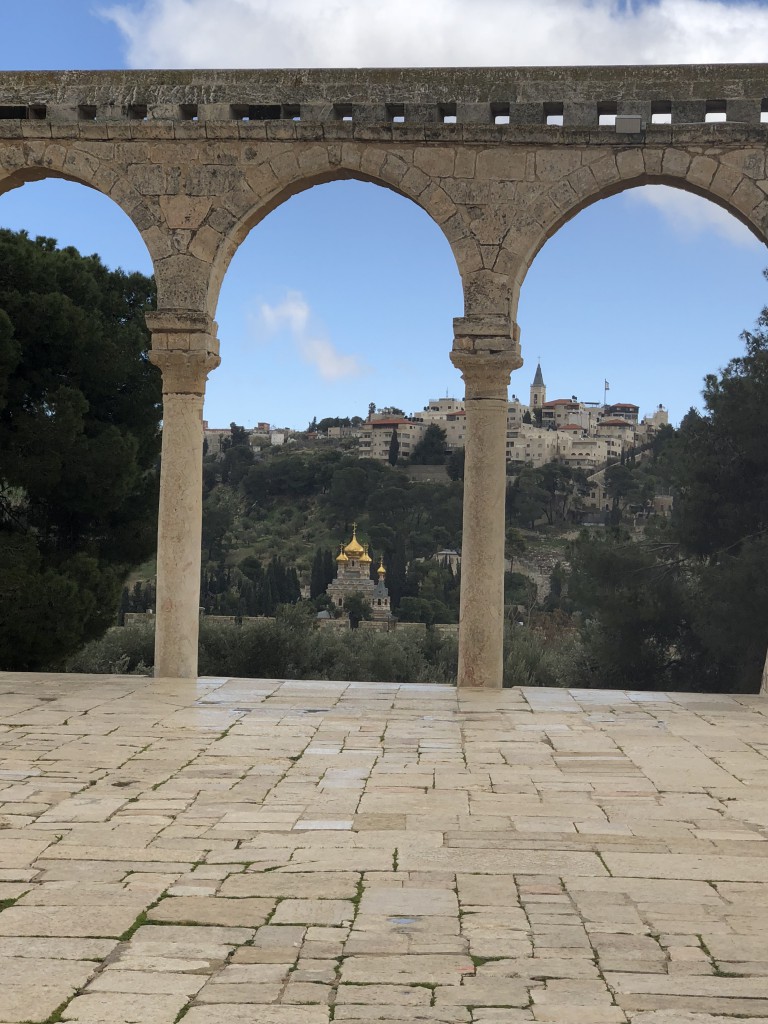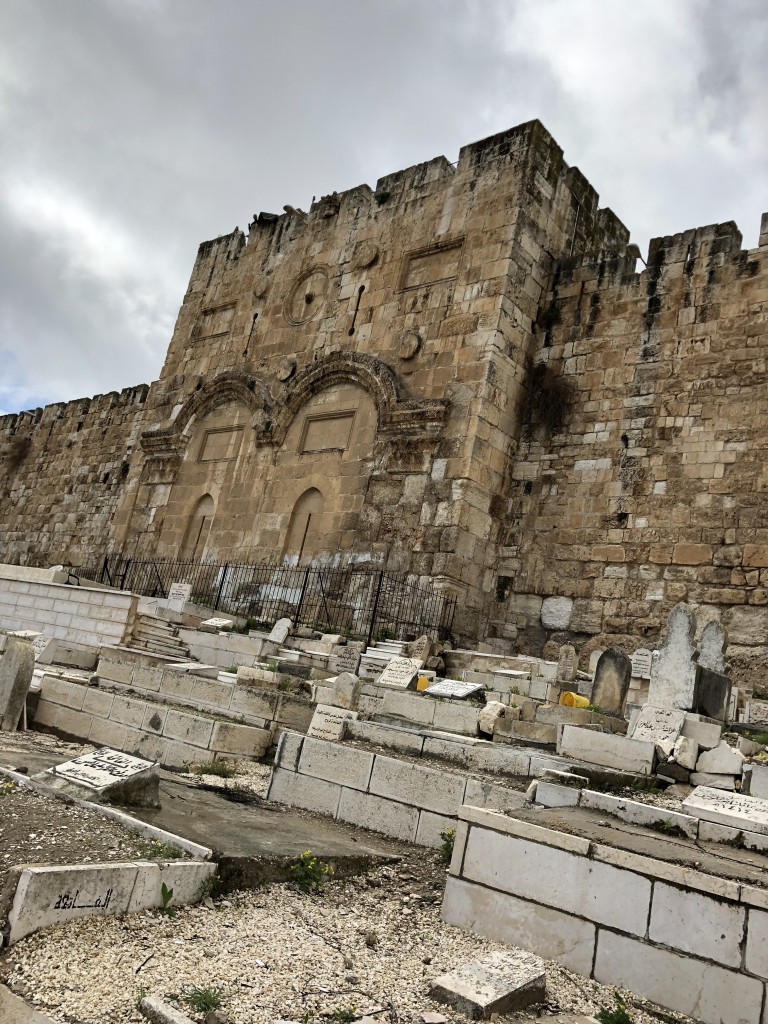
As promised in my last blog post I said I would talk about the ‘Golden Gate’ this is on the eastern side of Al-Aqsa compound and it faces the Mount of Olives. It also has the Muslim burial site besides it. It is known to be one of the oldest gates of the Old City with accounts of it being constructed from 6/7th Century A.D. The reason why I decided to cover this next is due to the opposite side of the gate i.e inside the compound is the residence of Imam Al-Ghazali while he resided in Al-Aqsa, you can read my last blog post for more information.
All three Abrahamic faiths have a significance for this gate, and we will explore them all a little bit more. Before I do I want to highlight that I have researched as much as I possibly can but many things have got arguments for and against. As much I want to share this with you, I always suggest you do research of your own and also always be mindful that there are certain things that are up for contention. I am in no way a scholar or someone who knows it all, I just visited and thought I would share my story, ultimately Allah-hu-Alam (Allah knows best).
The interior of the gate was reopened in February 2019 for worshippers by the Waqf after 16 years.
In case you are wondering how many gates there are there are 15 gates in total, 10 of these gates are open five are closed. There are the following:
Open Gates
Bab-al-Asbat (The Tribe’s Gate)
Bab-al-Hittah (The Gate of Remission)
Bab-al-Atim (The Gate of Darkness)
Bab-Ghwanimah (Gate of Banu Ghanim)
Bab-an-Nadhir (The Inspector’s Gate)
Bab-al-Hadid (The Iron Gate)
Bab-al-Qattani (Cotton Merchant’s Gate)
Bab-al-Matarah (The Ablution Gate)
Bab-as-Salam (Tranquility Gate)
Bab-al-Silsilah (Chain Gate)
Bab-al-Magharibah (The Moroccan Gate)
Closed Gates
Bab-al-Dhahabi (Golden Gate)
The Funeral’s Gate
The Double Gate
The Triple/Huldah Gate
The Single Gate
You can read more on each of these gates here: http://masjidalaqsa.net/gates/
I digress back to the gate in question Bab-al-Dhahabi (Golden Gate) this gate has many different names across the Abrahamic faiths, so the Golden Gate is taken from Christian Literature, in Hebrew it is known as Sha’ar Harachamimi ‘Gate of Mercy’ and Muslims have known to call in Bab-al-Dhahabi (Golden Gate), another Arabic name is the ‘Gate of Eternal Life’. Additionally, for Muslims each of the two doors of the double gate has its own name: Bab al-Rahma, ‘Gate of Mercy’, for the southern one, and Bab al-Taubah, the ‘Gate of Repentance’, for the northern one.
The most recent sealing of the gate was by Ottoman Sultan Suleiman in 1541. The exterior face of the gate, is a sealed double entrance that leads to two vaulted halls (where Imam-al-Ghazali resided while at Al-Aqsa).
Muslims place significance at this location as some believe that this is the site of Allah’s final judgement.
Jewish literature details that when the Messiah (the deliverer of the Jewish nation) arrives, he will enter Jerusalem through the Eastern Gate. On the holiday of Yom Kippor (Day of Atonement), a Temple messenger was sent through this gate with a sacrificial lamb to the desert. Therefore, the gate holds historical and traditional significance for the Jews, as well as remaining an indicator of the Messiah who is meant to come.
In Christian literature, the Gate is the place which the parents of Mary met after the Annunciation. Also, apocrypha texts in Christianity also detail that Jesus passed through the gate on Palm Sunday. Additionally, there is belief that Jesus will pass through these gates again as the Messiah.
The gate has been closed and reopened a few times, most recently being closed by Ottoman Sultan Suleiman in 1541. Before this time the gate was closed in 810 by Muslims, reopened in 1102 by the Crusaders, and then closed again by Salahuddin after defeating the Crusaders in 1187. Many believe that the gate was closed by Sultan Suleiman as a preventative measure to stop the Jewish Messiah from entering the gate, Christians believe it is to prevent Jesus from entering, including a Muslim graveyard being built in front of it as the Messiah will be unable to cross the graves. There are many different versions and reasons. This is a summary of what I did find to be the majority consensus.
The story about the gate really fascinated me and thought I would share this with you.
Opposite this gate is Mount Olives, the Jewish graveyard, the Church and Convent of Mary Magdalene, Gethsemane (is an urban garden at the food of Mount of Olives in Jerusalem famous for where some Christians believe Jesus prayed and his disciples slept the night before his cruxification. There are many other significant points here which matter to the Abrahamic faiths in some capacity.
The Muslim graveyard, Ma’man Allah cemetery, is right next to the Golden Gate where some Companions of the Prophet Muhammad (Peace be upon Him) are buried.
Ubadah bin-as-Samit – A dedicated follower of the Prophet, it is said that As-Samit fought alongside Muhammad (Peace be Upon Him) in every major battle of the era. He is also claimed to be one of the scribes involved in penning the Holy Quran.
His conversion to Islam came at a relatively early stage of the Prophet’s hijrah from Makkah to Medina, becoming one of the first 12 to embrace the religion prior to the journey. He was appointed as the first teacher and judge of the Palestinian people by the second caliph of the Rashidun Caliphate, Umar (ra). He is believed to have spent some period of time in the city of Jerusalem where he is also reported to be buried. The location identified as his final resting place is situated in the Ma’man Allah cemetery.
Shadaad bin-Aus – also buried at Ma’man Allah, one of the oldest cemeteries in the city, bin-Aus was one of the closer companions of the Prophet. He is believed to have narrated hadith directly from Prophet Muhammad (Peace be Upon Him).
Although burial areas are open to opinion it does prove the significance of Al-Aqsa to all Abrahimic faiths. Like I said earlier in this post, I would always try and research as much as possible yourself.
Finally, as part of this blog I am also going to discuss an area which again has contention of whether it was this spot or not but however we still visited this area of the Al-Aqsa compound. This building below, located at the rear end of the Al-Aqsa compound is believed by some (it cannot be confirmed) to be the place where the Prophet Sulayman (Peace be Upon Him) passed away while leaning on his staff, it is not too far from the backend of the ‘Golden Gate’, so if you are heading in that direction I would advise visiting the graveyard, Al-Ghazali residence and this spot all at the same time.
Just to expand on the story a little more, Sulayman (AS) was sitting holding his staff, overseeing the jinns at work. He died sitting in this position. For a long time, no one was aware of his death, for he was seen sitting erect.The jinns continued with their toil, thinking that the king was watching over them. Days passed in some cases people say a year passed, and the king’s death became known only when his supporting walking stick, eaten by termites gave way and the body fell to the ground. Allah makes mention in the Quran: “They worked for him as he desired, making arches, images, basins as large as reservoirs, and cooking cauldrons fixed in their places: “Work you, sons of David, with thanks!” But few of My servants are grateful.Then, when We decreed Solomon’s death, nothing showed them his death except a little worm of the earth that kept slowly gnawing away at his staff: So when he fell down, the jinns saw plainly that if they had known the unseen, they would not have tarried in the humiliating penalty of their task.” (Surah Saba 13-15)
If you’re curious who I travelled with it was Zaarvel. You can read my blogs from my first visit to Al-Aqsa here:
http://jeedajoseph.co.uk/bayt-ul-muqadas-meeting-siham/
http://jeedajoseph.co.uk/al-quds-walking-in-the-footsteps/
http://jeedajoseph.co.uk/ilm-the-travel-for-knowledge-and-spirituality/
http://jeedajoseph.co.uk/the-pulpit-of-salahuddin/
http://jeedajoseph.co.uk/discovering-tatreez/











Leave a Reply